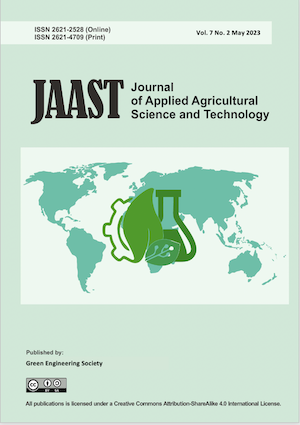Study on The Causes of Flooding in Batang Mahat, Lima Puluh Kota Regency, West Sumatera
##plugins.themes.academic_pro.article.main##
Abstract
This research is located in Batang Mahat Lima Puluh Kota Regency, about 9.26 km2 from the narrowing location at Batu Kisok to the upstream, prone to flood. Due to several flooding events in Batang Mahat, various assumptions and hypotheses have emerged regarding the causes of Batang Mahat flooding. This research analyses the causes of flooding in Batang Mahat using Steady Flow simulation in HEC-RAS 6.2 software. The result implies that two factors caused the flood: (1) The channel capacity is insufficient to accommodate flood water discharge, where the simulation results shown at the Q50 discharge (2003.07 m3/s) flood inundated several areas in cross-sections upstream and tributary. (2) The impact of the narrowing location at the river channel in Batu Kisok, which is shown by the simulation of a decrease in water elevation at eight cross-sections at the upstream and two cross-sections at the tributary after the cross-sections in Batu Kisok are widened from ±30 m to ±45 m (50%), ±60 m (100%), and ±75 m (150%).
##plugins.themes.academic_pro.article.details##

This work is licensed under a Creative Commons Attribution-ShareAlike 4.0 International License.
References
- Abass, K. (2020). Rising incidence of urban floods: Understanding the causes for flood risk reduction in Kumasi, Ghana. GeoJournal, 87(2), 1367-1384. https://doi.org/10.1007/s10708-020-10319-9
- Ahmad, D., & Afzal, M. (2022). Flood hazards and agricultural production risks management practices in flood-prone areas of Punjab, Pakistan. Environ Sci Pollut Res, 29, 20768–20783. https://doi.org/10.1007/s11356-021-17182-2
- Amoako, C., & Boamah, E. F. (2015). The three-dimensional causes of flooding in Accra, Ghana. International Journal of Urban Sustainable Development, 7(1), 109-129. https://doi.org/10.1080/19463138.2014.984720
- Balgah, R. A., Ngwa, K. A., Buchenrieder, G. R., & Kimengsi, J. N. (2023). Impacts of Floods on Agriculture-Dependent Livelihoods in Sub-Saharan Africa: An Assessment from Multiple Geo-Ecological Zones. Land, 12(2), 334. https://doi.org/10.3390/land12020334
- Balica, S. F., Popescu, I., Beevers, L., & Wright, N. G. (2013). Parametric and physically based modelling techniques for food risk and vulnerability assessment: a comparison. Environ Model & Software, 41, 84–92. https://doi.org/10.1016/j.envsoft.2012.11.002
- Buchenrieder, G., Brandl, J. & Balgah, A. R. (2021). The Perception of Flood Risks: A Case Study of Babessi in Rural Cameroon. Int J Disaster Risk Sci 12, 1–21. https://doi.org/10.1007/s13753-021-00345-7
- Dalrino, Sadtim, Hartati, & Agus, I. (2018). Analisis Kapasitas Penampang Sungai Batang Mahat Terhadap Besaran Debit Banjir Menggunakan Pendekatan Model Matematik. JIRS, 15(2), 1-11. https://doi.org/10.30630/jirs.15.2.124
- FAO. (2015). The Impact of Disasters on Agriculture and Food Security; Food and Agriculture Organization of the United Nations: Rome, Italy. https://reliefweb.int/report/world/impact-disasters-agriculture-and-food-security-2015
- FAO. (2017). The impact of of natural hazards and disasters on agriculture, food security and nutrition. https://www.fao.org/3/I8656EN/i8656en.pdf
- Herdianto, R., Istijono, B., Syofyan, E. R., & Dalrino. (2018). Investigation of Pangkalan Floods: Possible Reasons and Future Directions. International Journal on Advanced Science, Engineering and Information Technology, 8(6), 2510-2515. https://doi.org/10.18517/ijaseit.8.6.5825
- Junaidi & Syandriaji, D. (2023). Photogrammetry Technology by Using DJI Phantom 4 RTK in Batang Mahat, Lima Puluh Kota Regency West Sumatera. Jurnal Ilmiah Rekayasa Sipil, 20(1), 61-70. https://doi.org/10.30630/jirs.v20i1.1055
- Junaidi, A., Nurhamidah, N., & Daoed, D. (2018). Future flood management strategies in Indonesia. MATEC Web of Conferences, 229, 01014. https://doi.org/10.1051/matecconf/201822901014
- Khan, D. M., Veerbeek, W., Chen, A. S., Hammond, M. J., Islam, F., Pervin, I., Djordjević, S. & Butler, D. (2018). Back to the future: Assessing the damage of 2004 Dhaka flood in the 2050 urban environment. J. Flood Risk Manage, 11: S43-S54. https://doi.org/10.1111/jfr3.12220
- Manhique, A. J., Reason, C. J. C., Silinto, B., Zucula, J., Raiva, I., Congolo, F., & Mavume, A. F. (2015). Extreme rainfall and floods in southern Africa in January 2013 and associated circulation patterns. Natural Hazards, 77, 679-691. https://doi.org/10.1007/s11069-015-1616-y
- Oktaga, A.T., Suripin, & Darsono, S. (2015). Perbandingan Hasil Pemodelan Aliran Satu Dimensi Unsteady Flow dan Steady Flow pada Banjir Kota. Jurnal Media Komunikasi Teknik Sipil, 21(1), 35-46. https://doi.org/10.14710/mkts.v21i1.11229
- PSDA. (2017). Laporan Pendahuluan Pekerjaan Pengukuran Sungai Batang Mahat Kabupaten Lima Puluh Kota, Sumatera Barat. Padang: CV: Intikarya Tiga Mitra-Engineering Consultant.
- Qari, H. A., Jomoah, I., & Mambretti, S. (2014). Flood management in highly developed areas: problems and proposed solutions. Journal of American Science, 10(3), 10. https://www.researchgate.net/publication/260794773
- Rahman, M. S., & Di, L. (2020). A Systematic Review on Case Studies of Remote-Sensing-Based Flood Crop Loss Assessment. Agriculture, 10(4), 131. https://doi.org/10.3390/agriculture10040131
- Remo, J. W. F., Pinter, N., & Mahgoub, M. (2016). Assessing Illinois’s flood vulnerability using Hazus-MH. Natural Hazards, 81, 265-287. https://doi.org/10.1007/s11069-015-2077-z
- Syahputra, A., Sukiman, A. P., Dalrino, & Aguskamar. (2019). Simulasi Debit Banjir pada Sungai Batang Mahat Menggunakan Pendekatan Numerik dan Data Hujan Satelit. 6th Andalas Civil Engineering Conference (ACE). 664-674. https://conference.ft.unand.ac.id/index.php/ace/Ace2019/paper/view/1174
- Tanir, T., de Lima, A. de S., de A. Coelho, G., Uzun, S., Cassalho, F., & Ferreira, C. M. (2021). Assessing the spatiotemporal socioeconomic flood vulnerability of agricultural communities in the Potomac River Watershed. Natural Hazards, 108(1), 225–251. https://doi.org/10.1007/s11069-021-04677-x
- Tella, A., & Balogun, A. L. (2020). Ensemble fuzzy MCDM for spatial assessment of flood susceptibility in Ibadan, Nigeria. Natural Hazards, 104(3), 2277-2306. https://doi.org/10.1007/s11069-020-04272-6
- Ullah, F., Saqib, S. E., Ahmad, M. M., & Fadlallah, M. A. (2020). Flood risk perception and its determinants among rural households in two communities in Khyber Pakhtunkhwa, Pakistan. Natural Hazards, 104, 225-247. https://doi.org/10.1007/s11069-020-04166-7

